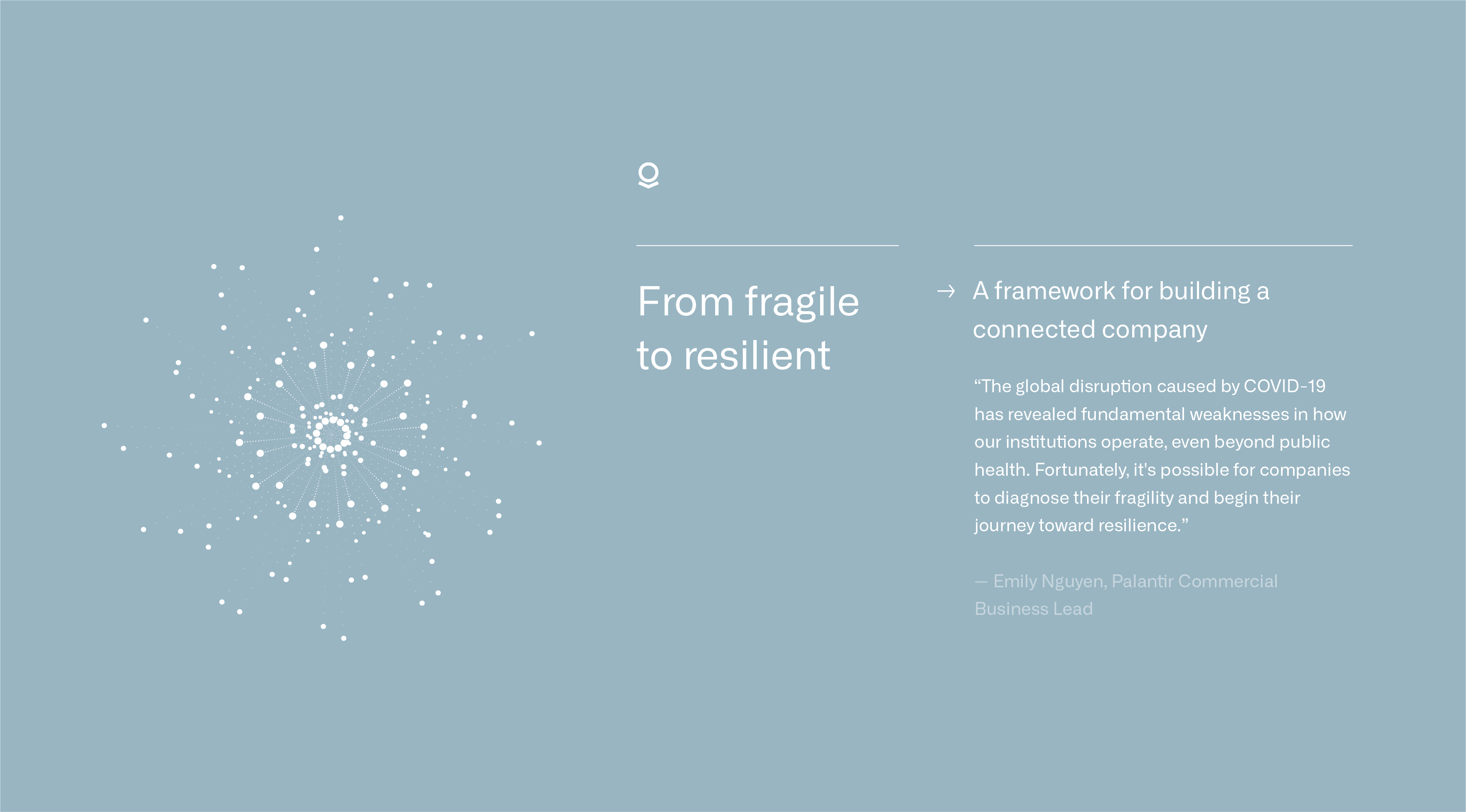The global disruption caused by COVID-19 has revealed fundamental weaknesses in how our institutions operate, even beyond public health. Sudden changes in the social and economic landscapes have created operational stressors and blockages that many organizations are not equipped to handle — demand fluctuates drastically just as supply chains unravel. Circumstances change daily, and as companies try to pivot and adapt, they’re uncovering the fragility that underlies their operations.
Operational fragility isn’t necessarily a function of poor leadership or insufficient crisis response planning. Frequently, it’s caused by a different problem altogether: an inflexible, disconnected technology architecture. Systems become fragmented to manage complexity and are fraught with assumptions, baked into automation, that reflect a simpler world than the one in which we live. Fortunately, it’s possible for companies to diagnose their fragility and begin their journey toward resilience.


In this post, we provide a three-question self-assessment for companies to measure themselves on a spectrum of fragility and a set of simple steps businesses can take to build resilience.
How long would it take you to get basic status information about the operational units of your company?
- Manufacturing: How long would it take you to understand inventory levels and current location (factory, distribution center, in-transit, at store) for any given Stock-Keeping Unit (SKU)? How easily could you connect that to customer orders? How easily could you get a 7 day forecast for inventory?
- Airlines: How long would it take you to understand how many planes are grounded today due to unplanned maintenance? How easily could you connect that to the flight routes they were supposed to serve?
- Media: How long would it take you to understand the forecasted audience for a particular show on linear and on digital channels?
- Oil & Gas: How long would it take you to understand how many wells in your global stock are shut in for well work? And what is the expected return on those interventions?
This information should be instantly accessible and updating in near real time. It is the foundation of a Common Operating Picture that informs strategy and action. If the answer is “it would take me some time so pull a report and by the time I got it, it may already be out of date,” you may have a fragile business.
Think about a decision that gets made by employees at your company. How long would it take you to change their objective function? And measure the efficacy of that change?
- Manufacturing: Let’s say you wanted to change the customer prioritization on filling orders from First In, First Out (FIFO) to include a maximum allocation or to prioritize certain industries. How quickly could you get your supply chain managers to comply? How would you measure adherence to this strategy?
- Airlines: Let’s say you wanted to change the prioritization for swapping aircraft. How quickly could you get the Network Operations Center (NOC) to comply? How would you know how often they were making exceptions?
- Media: Let’s say you wanted your sales force to focus on selling specific inventory (e.g., digital) rather than pushing total volume. How quickly could you influence their process? How would you measure adherence?
- Oil & Gas: Let’s say you wanted to change the prioritization of well maintenance in an effort to increase the threshold for expected return. How quickly could you get your petroleum engineers to adopt this new policy? How would you measure the results?
There should be a mechanism in place to influence regular decision-making processes by introducing additional variables to consider or new objective functions. And it should be seamless to track adherence and efficacy. If the answer is “I’m not quite sure; I’ve actually never done it” or “I could announce a policy change, but not be certain who was following,” you may have a fragile business. Of course, a major operational change won’t be instantaneous; there will be some amount of lag time, taking into account change management and adoption. But, a resilient business understands how decisions are made and can influence those processes. Moreover, it can measure in a data driven way strategic adherence and effectiveness over time.
Consider an automated process that runs at your organization. When was the model that guides that process last updated?
- Manufacturing: When was the last time you updated your demand forecasts? Do simply rely on out-of-the-box models or have you adjusted them to fit your business?
- Airlines: When was the last time you updated your revenue model for pricing airfare?
- Media: When was the last time you updated your pricing model for inventory?
- Oil & Gas: When was the last time you updated the physics-based models of your reservoir, well, and surface network models?
Models that guide decisions should be updated routinely. If the answer is on the scale of “years,” you may have a fragile business. Models don’t need to be constantly re-built; but, and as the world the model was built in changes, that learning should be folded into your model to keep it performing optimally. If you aren’t doing this, you may be propagating brittle processes.
Building operational resilience requires bettering many different aspects of the business, from fostering a culture of responsibility and empowerment to adopting a lexicon for digital transformation. However, as revealed by the questionnaire, the most crucial element is establishing connectivity, both in data and decision-making.
This rings true under normal circumstances, but becomes even more crucial during times of crisis, when ascertaining basic facts about your operations dictates your ability to adapt. In times of rapid change, it’s critical to have immediate, unimpeded visibility into all branches of your operational structure. A well-integrated central data asset allows organizations to communicate more efficiently, make decisions more quickly, and collaborate more authentically.
The steps taken to cultivate data connectivity in a way that builds operational resilience are: develop the Common Operating Picture, use the integrated data asset to drive action, seek a global optimum, and fuel learning.
Develop the Common Operating Picture
Bring together data from all relevant systems and model it into an “ontology,” a set of real-world objects that are easily understandable and widely applicable throughout your business. For instance, a manufacturer’s ontology might include objects like Customers, Contracts, Suppliers, Raw Materials, Batches, Shipments, Plants, Work Centers, Distribution Centers, Inventory, and Promotions.
Mapping data from Enterprise Resource Planning (ERP) systems, Customer Relationship Management (CRM) repositories, Manufacturing Execution Systems (MES), and other siloed assets onto these real-world objects promotes cross-functional collaboration and is key to making the Common Operating Picture work for the full company, not just a subset. While only certain production operators may be familiar with the intricacies of the data behind specific work centers and machines, everyone can understand the pertinent ontological labels like ’Shipments’ and ‘Inventory’.
With these components, integrated thoughtfully and responsibly, you should be able to develop object views that give you the state of the world and flexible reports to answer ad hoc questions.
Use the integrated data asset to drive action
Information alone is not enough — you must apply strategy to the data and put it in the context of a workflow to drive action.
Think foremost about the workflow you want to enable — what metrics and data points are used today? How can you bring new data points and metrics into that process? In the case of an airline, can you maximize the use of downtime cause by delays and/or outages to attend to maintenance needs as well? For an oil and gas company, given a well shut-in, how can you respond to maximize production from other wells?
Data should always empower action. New metrics can compound value when integrated thoughtfully with user workflows. However, without careful consideration, new ways of working can make users’ day-to-day life substantially more difficult through unnecessary redundancies and latency. Always ask yourself what is difficult about users’ processes today and how can software create efficiencies for tomorrow.
Seek a global optimum
The process of building resilience through data connectivity doesn’t stop with streamlining one workflow, or the workflows of a single team. Instead, the aim should be to push towards a global optimum, rather than a local one.
Can you connect one set of target decisions to related decisions either upstream or downstream? Consider how you can link the business logic of one decision to the business logic of another decision; as links multiply, ask how these connections can begin to form a model that allows for scenario planning.
For example, as a media company, how can you price deals to incentivize advertisers to buy more digital products, in addition to linear? Can you coordinate your sales teams’ incentives and pricing strategy to move in this direction? Can you savvily promote digital content on linear channels to gradually shift the audience? A global optimum won’t happen all at once. But, as you continue to connect decisions both upstream and downstream, you’ll grow a web of business continuity and connectivity.
Fuel Learning
The job is still not done. As you collect these decisions from across the organization and connect them, you must also build an infrastructure to capture their results. Decisions and outcomes should be fed back into your models to continually measure and refine. Capture not only the outcome but the conditions that lead to the outcome, and this can become a critical dataset in continuous improvement and building resilience.
For manufacturing companies, can you feed signal regarding customer orders back into your forecast to improve accuracy in real-time? As an airline, can you use ongoing maintenance data to drive preventative decisions?
By enabling your system to learn from ongoing decisions, you effectively close the loop on data connectivity. Outcomes inform the system, which drives future outcomes. This process accelerates until even small variation prompts an agile repositioning of the system as a whole. It also means that the system is resilient to sudden, drastic change during times of crisis.
Embarking on this journey is daunting but vital, now more than ever. It’s important to note, this is not an all-or-nothing process — your organization should realize value with every step. If done well, investing in connectivity across your company will not only help you become more resilient during times of crisis but thrive under normal operating conditions.
Author
Emily Nguyen, Palantir Commercial Business Lead
